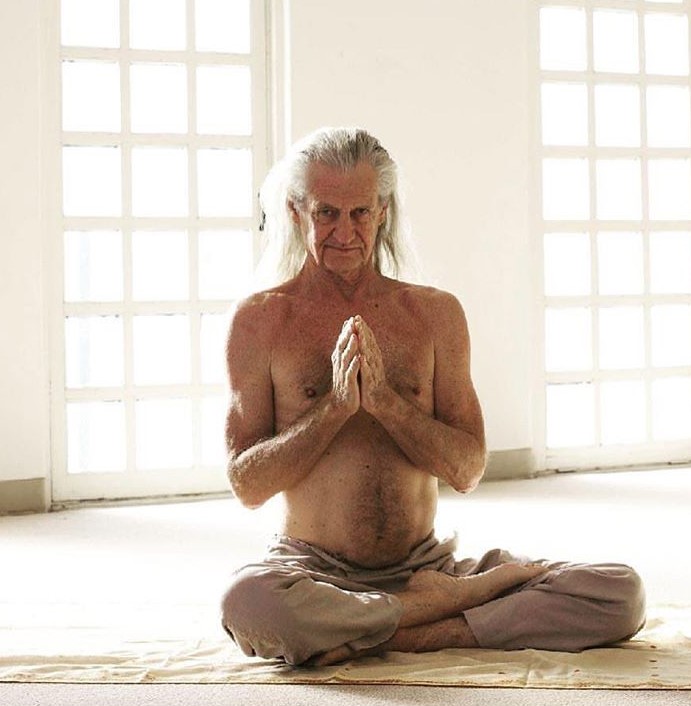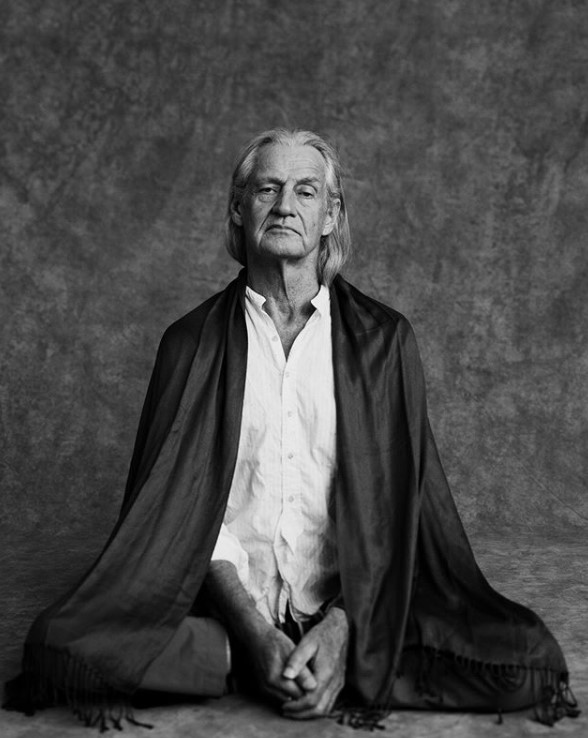On a moonlit night in 1973, I was standing on a rooftop in Madras, thousands of miles from my home in the South Pacific. Having met with my teachers, Krishnamacharya and Desikachar, I was suddenly filled with a sense of wonder. It was sublime: a deep, spontaneous feeling of well-being, bliss, and love. I felt completely nurtured, my whole body fully integrated with everything in the natural world and with everyOne around me.
What had caused this wonder-full feeling? There was no external reason: no girl, no drugs, no hit on the head with a peacock feather from Swami Knowitall-ananda. Yet there I was, under a full moon and infinite stars, blissfully alive and certain of the simplest realization. “This body loves its breath,” I whispered to the night crickets.
I felt how loving one’s own breath is the most basic intimacy there is, and not difficult. You don’t need to be particularly smart to do it, and no special or secret knowledge is required. It is for everyOne. And this basic intimacy enables love of all else, including the expression of utterly receptive strength in nature’s female-male collaboration that is enacted via inhale-exhale. It makes blissful polarity possible in all intimate relationships.

In the intervening years, I have shared this Yoga—the basic embrace of life through intimacy with body and breath—with many people, from many countries and all walks of life. We are united by the fact that everyOne breathes. Along the way, I have noticed with pain how almost everyone’s relationship with body and breath (and therefore life) is compromised. Overload, painful experiences, the pressure to always be better, and the constant busyness of the modern world mean that most of us do not feel the constantly available nurturing force of life that breathes us and is us. We suffer from the illusion that we are abandoned by Life/God/Nature/the nurturing force. And I have seen how as a result of this imagined but painful dissociation, most are suffering pain and dysfunction in their sexuality and relationships. We cannot connect with others when we are disconnected from ourselves and the world.
But conversely, I have seen thousands of yoga practitioners from around the world—men and women—empowered in their relationships as they begin to participate in the natural state, beginning with embrace of their own breath. Practitioners come to feel the union of opposites in their own system—strength that is receptive—through appropriate practice, and dissolve the painful conditioning of male-female politics.
I write now because this is where we are stuck. 2017 was the year when the pain of male-female dysfunction became inescapably public. From Trump’s misogyny, to the public exposure of predatory powerful men, to the widespread questioning of everyday patriarchal norms, we are seeing how everyone is affected by society’s dysfunction in this area. And because this is being expressed in public dialogue, I want people to know there are practical steps that can be taken to heal the pain in this area.
When I look around and see the big mess, I feel great compassion for all involved, knowing there is a practical way for them to become intimate with life and the power of their own reality. It is such a joy to meet people who want to begin to practice, or who are already practicing, doing something practical for themselves to end the toxic dynamics. I hope all can be inspired to get the practical help that is available to move our society past the suffering. It’s important to me because people are important to me. Evolution from male-female politics to the peace and power of the natural state is possible, and it is urgent.
More and more of us can now recognize that masculinity as we know it is in a state of crisis. ‘Patriarchy’ and ‘misogyny’ are no longer abstract forces to be raged against by undergraduates; they are recognised as pervasive cultural norms causing great pain and dysfunction for everyone. The everyday experiences of sexual assault, harassment, and inequality are being brought out into the light for serious public discussion, and this is overdue.
Due to the trauma, pain, shame, and other difficult emotions involved, however, the conversation often stalls into blame and scapegoating. There is a lot of information about the harmful behaviour of predatory men like Harvey Weinstein, and analysis of why it’s bad. There are plenty of outraged calls for different behaviour. And there is even some recognition that such men are particularly toxic examples of a problem that runs right through society, rather than individual moral failures.
But why is masculinity as we know it so toxic? And what can we actually, proactively do to heal and move forward? If we don’t understand the causes, we won’t be able to heal the disease. Moral demands don’t have the power to effect real transformation, however righteous and passionate.
We need to examine how masculinity as we know it is founded on a systemic denial and abuse of the feminine—which doesn’t just mean women, but the whole open, receptive, wild, embodied, creative force of life. In denying the feminine for so many centuries, we have actually denied life itself, both within ourselves and others, and in the living, breathing more-than-human world.
For the sake of all, we urgently need a new masculinity based on collaboration and intimacy rather than disconnection and objectification, and we need the practical means to make this a reality rather than just a nice idea. We need to relearn how to receive our own life, so we can naturally receive another’s.

Understanding Masculine and Feminine
To avoid the ‘men versus women’ debate, consider the Yogic understanding that masculine and feminine are just words to describe two forces that exist everywhere in mutual polarity, like the positive and negative forces within every atom. We all have both within us in perfect balance, no matter our sex or gender identity. We all come from mother and father, and all of us contain the male-female equation of life—strength and receptivity—in perfect union.
So a discussion of toxic masculinity is not just pointing to an attitude problem in men. The issue is bigger than that: humanity has a long-standing habit of associating masculinity with men and femininity with women and then privileging the masculine over the feminine. The result has been a big, painful mess for all.
Denial of the Feminine
Our predecessors had no idea what to do with the power and vulnerability of the wild feminine. Alarmed by this uncontrollable, ever-changing world, they attempted to control and escape the feminine—the body, the world, feeling, and reality itself. Rather than participating peacefully in the great mystery of life and death, they created myths of eternity and transcendence, abstracting themselves away from life. God was in the sky, and they were the ones with access rights.
Religious and political institutions have furthered this fearful search for dominance over the living world, in the process rapaciously controlling the Earth, women, indigenous peoples, and each other. They believed and taught that the world was dead, mechanical, and there to be used and abused. These doctrines have sunk deep into our collective psyche, dissociating us from the sublime regenerative force of life that is everywhere and that it is our birthright to feel. Fear of death has resulted in fear of life, and we have inherited disconnection and numbness.
The modern form of this denial can be seen in our gender norms and expectations. Young men are taught that emotion is weak and receptivity is unmanly, that the correct approach to life is one of hard aggression, and that intimacy can only be gained through manipulation, ownership, and control of the feminine. From repressive celibacy to pornographic sexual exaggeration, the impulse to dominate and control is the same. Masculinity as it has been defined and enforced is a dysfunctional social idea that deprives men of feminine power and real intimacy.
Power divorced from receptivity and feeling is not strong at all, but rather destructive and brittle, with war as its most extreme expression. Real strength, real masculinity in balance, is able to receive and support the feminine, rather than control or dominate it.
Sexual assault and other forms of dysfunctional sexual behaviour all stem from this denial of the feminine. When a person is not given the means to feel the power of their own life, which is already given and one hundred percent constant, all kinds of warped attitudes to sex are created, including the struggle to control it and get it. All along it has been freely given as our own very nature. We seek to get what we cannot feel.
Yoga as the Practical Means to Intimacy
Misogynistic indoctrination and intergenerational programming go deep, deeper than feminist or spiritual ideas that may be conceptually acquired in later life. Many men are making the painful discovery that their own behaviour has enacted the age-old use and abuse of the feminine, despite their best conscious or stated intentions. Good ideas and moral doctrines are not enough to overcome the deep brainwashing that has occurred.
To move forward and heal the collective and individual pain, we need to go beyond guilt, blame, and anger. We must grieve for the whole stupidity of the circumstance and have some compassion for ourselves and others. It takes courage to acknowledge just how numb and dissociative from ourselves, each other, and reality our modern culture has made us, whether or not this withdrawal has led to obvious abuse.
Once men have the courage to tangibly see how they have participated in the misogynist culture that’s been handed to them, they require the practical means to move in an entirely different direction to the patriarchal norms they unfortunately inherited. They need the tools to be free of the unconstructive anguish of guilt and the dissatisfaction felt at having been denied fulfilling intimacy with life or with another.
Authentic yoga is this practical means: the simple, ancient system whereby every person can learn to feel more and be receptive to the great wild power of life in themselves and everywhere. The Great Tradition of yoga offers us so much more than the physical workout or conceptual ‘spiritual’ game it is sadly often reduced to. Real yoga is strength receiving, participation in the union of opposites, and male-female collaboration as the power, intelligence and beauty of life itself. Men can learn that receptivity is more powerful than mere strength alone, and it is yoga that makes this visceral change.
Such yoga is not about getting anywhere, but a remedial practice to remind us what is already here, obscured by centuries of patriarchal dissociation. It is the birthright of every man and woman to feel all that there is to feel; and when a person is able to receive life through fully feeling, sexuality will be real, respectful, honest, lawful, and a pure communication of love—the heart’s activity. This is possible.
Women, too, can learn this practical means of intimacy with life, and be relieved of the pain of needing to constantly be alert and defended against predatory males, as well as the pain felt due to the lack of fulfilling intimacy. A genuine yoga practice empowers women to recognize partners who have relearned the practice of receptivity as the real power of life and safely go there, free from the trauma of previous experience.
From this practical means comes the new feminism (and masculinism): male-female collaboration as equals and opposites in endless mutual exchange, each empowering the other. This is the generative, nurturing power of life itself, the very dynamic that’s already in every body, regardless of sexual preference or gender identity.
This is not a disparagement of earlier feminisms, whose valid anger has been a necessary survival mechanism that has paved the way for all women and men to be free. We are now able to observe, understand, and move quickly through all the necessary stages of emotion: fear, anger, the pain beneath the anger, and finally grief for the unnecessary circumstance imposed on all humanity.
The pain has become undeniable. We have inherited a big mess, but we now have the knowledge and tools to directly participate in our lives, cut through the heavy layers of dysfunction, and restore sexual intimacy to its rightful place as a function of the heart. This is my plea: that through practicing feeling and relatedness, we can come back to Earth and our bodies, finally end humanity’s violent struggle against the feminine, and restore the masculine to dignity and peaceful strength. Only then will we see the end of misogyny and abuse.

If you want to learn the principles of home Yoga practice that Mark discusses in this article you can join the 8-week online immersion by donation atwww.heartofyoga.com/online-immersion.
Internationally renowned Yoga Master Mark Whitwell (www.heartofyoga.org/mark-whitwell/about/) is passionate about keeping the heart in Yoga. He is interested in developing an authentic Yoga practice for the individual, based on the teachings of Tirumalai Krishnamacharya, “the teacher of the teachers,” and his son T.K.V. Desikachar. After first meeting these two great teachers in 1973, Mark realized the importance of their scholarship and committed his life to furthering the communication. Mark has taught Yoga for many years throughout the world, adapting the principles of the Great Tradition to the needs of people from many cultures and countries. He was the editor of and contributor to T.K.V. Desikachar’s classic, The Heart of Yoga: Developing a Personal Practice, and is the author of God and Sex: Now We Get Both, Yoga of Heart (https://www.amazon.com/Yoga-Heart-Healing-Intimate-Connection/dp/159056068X) and The Promise (https://www.heartofyoga.org/thepromise/). You can find info on upcoming workshops and teacher trainings around the world at www.heartofyoga.org, and contact Mark on Facebook @yogaofheart or on Instagram @markwhitwell.

